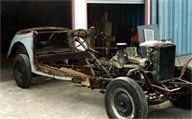Clarissa meets partner Jim and starts to strip
My partner in the project was my brother in law, Jim Maxwell, and he came down from Thames to look over Clarissa. Like me he got quite a shock over her poor condition and the amount of work required but agreed that if we were going to restore her then it should be done correctly. The amount of work that was required became a huge mental block to me, the more I thought about it the bigger the hurdle it seemed and the deeper I sank into depression. I needed a break so I went to Australia for a week to stay with friends, and with their help I eventually rationalised the problem and recovered from the shock.
While I was away Bill Davies and Steve set to work on Clarissa. Steve took off the outer guards, cleaned them and repaired the parts that were damaged with rust. Then off came the running boards and inner guards - these had to be discarded as they were far too rusty to be repaired, but not before new ones had been made from the pattern. Their aim was to tidy them up before priming and refitting. Bill knew how I was feeling when I went to Australia and wanted to show a dramatic improvement to help me gain a bit of enthusiasm.
On my return I called in to the museum to see what was happening with Clarissa. Bill must have known a thing or two about psychology because I got a huge surprise to see the car with red primer guards and running boards and I had a surge of enthusiasm. Steve, Linda and their children then left to work in the South Island for a time but promised to return next April to work again on Clarissa.
When Steve and his band arrived in April they got straight to work and started stripping the car down to a bare chassis, preparing it for sandblasting and painting, reconditioning the suspension and drive train and reassembling the rolling chassis. There was a lot of work to do.
The heavy doors were removed, with their brass hinges, glass and mechanism still attached. Next came the bonnet: someone must have sat on the bonnet at some stage because it had a sag in the middle. Steve took out the rods and was left with just four panels which with his hammer and dolly he soon had back in shape. They were then taken to Rotorua to be dip stripped and readied for restoration. Then the guards had to be bead blasted and painted. All in all, it took very little time to get a lot of big bits fixed up - and all at an encouragingly reasonable cost.
With the help and support of Bill, Steve and retired mechanic Len Nicholson, Jim and I also tackled various parts of the car that were within our capabilities. We took the brake cylinders and master cylinder to be re-sleeved in stainless steel. The seats were taken out and we discovered they would need rebuilding as the stitching had rotted and they would not hold any weight.

The seat runners needed straightening and reattaching and the floor had a few holes in it for Steve to repair. The rear seats were in better condition than the front, but for the sake of consistency they were to receive the same treatment.
We pulled out the dashboard and found that all of the wiring was rotten - just as well we had a complete wiring diagram! The instruments were carefully removed and sent off to be checked over. The steering wheel was cracked beyond repair and the magneto, starter motor and dynamo all needed to go to Auckland for rebuilding. After a bit of persuasion the firewall came out - it would also need a total rebuild.
Off came the soft top and hood irons next - a difficult task - how did they get the screws in at that angle and so tight? Removing the petrol tank, Andre telecontrols and shock absorbers was no easier - a difficult and time- consuming job that took chunks of skin off several knuckles. Next to be removed were the motor, gearbox and drive shaft, followed by the front scuttle.

The bolts holding the body on were rusty and had to be cut off, and with these released, the scuttle and rear body tub came away and we were left with just a chassis on wheels.
After pulling off the trim, the extent of the damage to Clarissa's frame had become evident: some of the woodwork was very rotten and some was very good, with little in between. It was not really salvageable, which was a bit of a blow.
We badly needed professional help.





